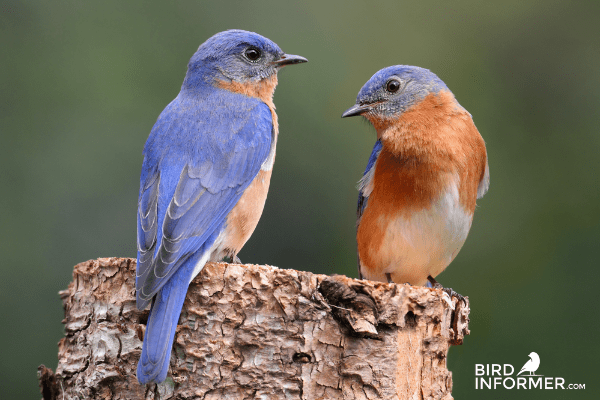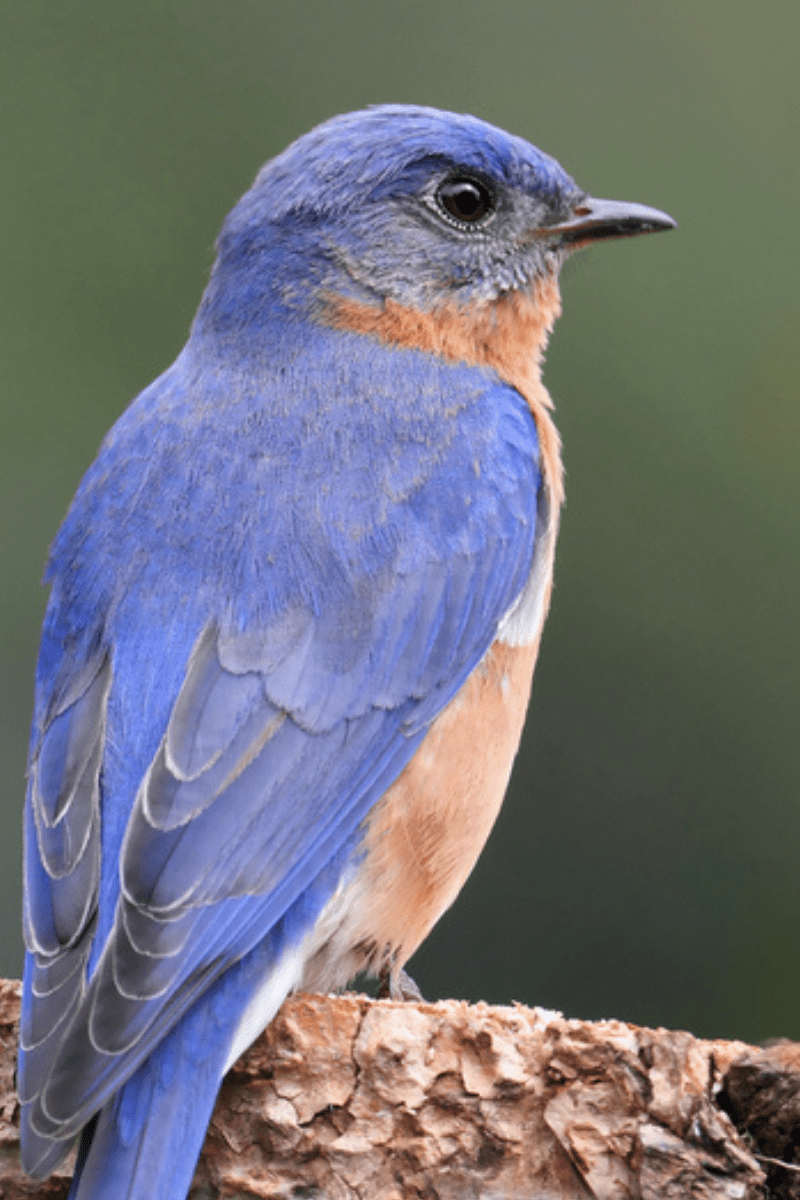Contents [show]
Are you trying to find out the true color of bluebird eggs? Find out the answer to this question and other important bluebird egg facts shared below. So, what color are bluebird eggs?
Bluebird eggs are the color blue, but they are also sometimes white or pink, but it’s rare. Specifically, the actual egg color is technically powder blue. Unlike other bird eggs, they don’t have dark spots on them. Bluebird feathers do not usually line the nest, but it does happen in rare instances.
Clearly, bluebird eggs are beautiful to look at and their powdery blue color is truly a sight to behold. Besides the information already shared, I’d like to tell you more about the reason they are the color that they are, how bluebirds lay eggs and other important facts that you might not know about.
To discover the truth about the color of bluebird eggs and so much more, please continue reading the information shared below.
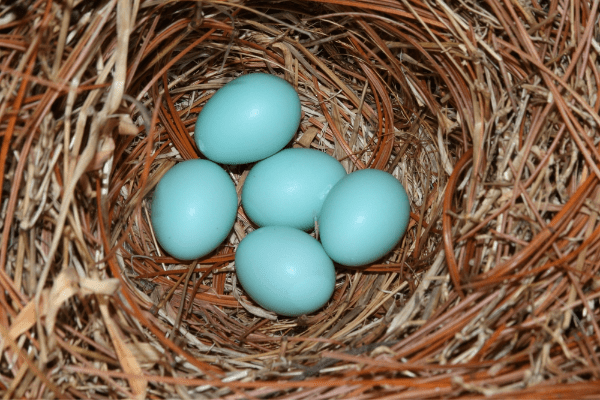
Why Are Bluebird Eggs Blue?
There is a very specific reason why bluebird eggs, robin’s eggs, and other blue eggs turn this color. It specifically has to do with the bile pigment biliverdin. It’s this pigment that provides the blue tones that we see when looking at birds’ eggs.
When the bird shell is formed within the shell gland, it is covered by specific pigments, which will ultimately determine the overall color of the eggshell. The shell gland can be found toward the back of the oviduct, which ultimately acts as an avian uterus.
The color of the egg can be arranged according to a number of different hues based on the bile pigment concentration. In some cases, like the bluebird egg, the pigmentation creates a powdery blue collar. In other cases, the egg might look pale ice blue, blue-green, or a bright and bold blue.
The smaller brood eggs that are first laid typically have a brighter and more intense coloration as opposed to the larger eggs, which usually appear during the nesting cycle at a much later time.
The pigment biliverdin isn’t just responsible for coloring bird egg shells. It’s also responsible for the blue tones and coloration in butterfly and moth wings. And when somebody gets bruised and the mark begins turning bluish-green, this happens because of biliverdin pigmentation as well.
Related article: Best Bluebird Feeders
Are Bluebird Eggs Colorful To Act Like Camouflage?
The short answer is no, the powdery blue bluebird eggs aren’t this color to act as camouflage. As an example, hens tend to lay brown creamy chicken eggs. They are this color to help the eggs blend in with their surroundings and act as camouflage.
This is typical of many different types of bird eggs because the coloration can camouflage the eggs and keep them hidden from other predators. Typically, the eggs with neutral tones have been specifically created this way to blend in with the background much better to keep them hidden, safe, and protected.
On the other hand, there is a very valid and specific reason why bluebird eggs are the color blue. Find out why the next.
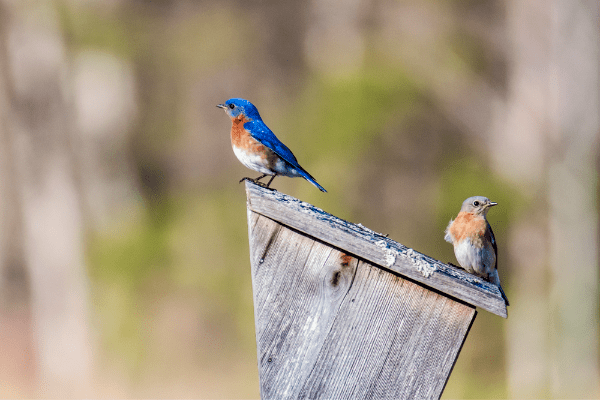
What Color Are Bluebird Eggs and How Does It Provide UV Ray Protection?
Believe it or not, the coloration of a bird egg is more than just a pretty sight. In the case of bluebird eggs, the darker color is designed to keep the egg and the unborn bird protected from harmful sunlight and ultraviolet rays.
The sun kicks off heat and radiation that can cause untold damage to delicate bluebird eggs. It could have a negative impact on the development of the hatchling inside and create unwanted problems during the incubation period.
For example, TheSpruce.com tells us, “A very dark egg, for example, will have better protection against harmful ultraviolet (UV) radiation, but it can also heat up too quickly in direct sunlight and the extreme temperature could kill an unhatched chick.”
As we learned earlier, bluebird eggs are a much later powdery blue as opposed to a very dark blue egg. So, this later egg isn’t going to have to fear stress caused by overheating. Unfortunately, on the other end of the spectrum, it does run the risk of potential developmental problems due to overexposure to UV radiation.
When the incubation period is taking place and the son is a major factor in egg development, the chicks that are born could end up facing more fatalities and larger mutations because of their rushed development.
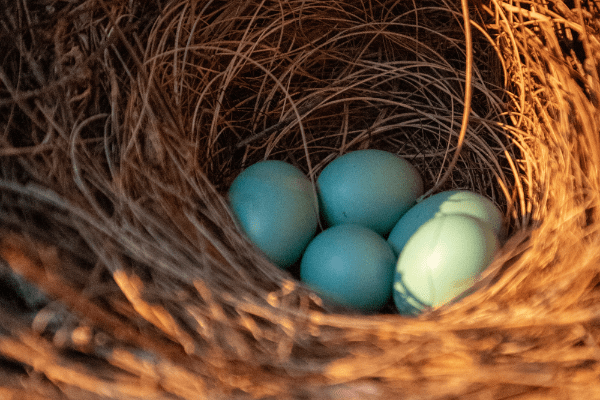
Eggshell Color Indications
- Chicks/Parental Health – when bird eggs are more colorful and brighter, this is usually a sign that the mother bird has eaten a good, healthy diet. Her hatchlings will end up healthy and strong more often than not.
- Careful Nesting Habits – more often than not, when an egg is colored to act as camouflage, like in our example above, this typically means that the parents must leave the eggs unattended so they can forage. More conspicuous, plain eggs are usually better guarded and well cared for by watchful parents.
- Sibling Mismatches – when egg colors are dramatically different within a nest, this can often indicate the presence of a brute parasite. Certain birds including common cuckoos and brown-headed cowbirds will lay their eggs and place them in another nest. The other species will foster these checks even though the eggs are a different color, shape, or size.
What Does It Mean Spiritually When You See A Bluebird?
Believe It Or Not, Bluebirds Have Spiritual Meanings! To Learn More About This, Click The Button Below.
Bird Species That Lay Blue Eggs
- Eastern bluebird
- American Robins
- European Robins
- Common Myna
- Great Tinamou
- House Finches
- Starlings
- Dunnocks
- Red-Winged Blackbirds
- Magpies
- Snowy Egrets
- Emus
- Blue Jays
- Blue-Footed Boobies
When Does A Bluebird Lay Eggs?
The nesting season for bluebirds typically begins in February and March if the bluebirds are located in the southern states of the United States of America. Bluebirds usually begin their egg-laying season in the colder states in the North during the months of March and April.
The season doesn’t begin and then female bluebirds immediately start laying eggs. That is not how it works. First, she needs to begin building her nest.
How Does Nest Building Take Place For Bluebirds?
Like many bird species, bluebirds have their own ways of establishing their territory and beginning their mating periods. As an example, the male will initiate a performance that can be best described as a nest-building display.
Remember, the male isn’t actually responsible for building the nest, so this can be a little bit confusing. During the nest-building display, the male bluebird will gather as much nesting material as possible and bring it into the new mating territory.
Why does the mail perform this ritual?
Strictly speaking, he is doing this to attract a female mate. He will bring this nesting material into a tree cavity or bluebird house in an effort to attract a female to mate with.
It’s important to know that bluebirds are known to mate for life. This is why many find it surprising that the female builds the nest on her own without any assistance from the mail.
All told, it typically takes the female bluebird roughly 5 ½ days to complete the nest from start to finish. The male bluebird is no longer a part of the nest-building process once he has finished gathering and securing all of the nesting materials for his female mate.
According to avianreport.com, “Some nesting territories have multiple cavities. Some pairs build a nest or the beginning of one in each cavity – however, the nesting pair use only one to lay the eggs and raise the young.”
Related article: What is the difference between a bluebird and a blue jay?
How Many Eggs Does A Female Bluebird Lay?
On average, a female bluebird will lay roughly 4-5 eggs per nesting season. Typically speaking, the clutch size will range anywhere from 2 to 8 eggs, depending on the bluebird species.
For example, a typical Eastern bluebird egg clutch is anywhere from 2-7 eggs. The Western bluebird, on the other hand, has an average clutch size of 2-8 eggs. The mountain bluebird tends to have a clutch size of 4-8 eggs. So, it varies depending on the particular species.
The different bluebird species may have more than one brood each year as well. The female Eastern bluebird could lay eggs up to three different times during the year. The same holds true with the Western bluebird. The mountain bluebird often has two broods in a single year, but no more.
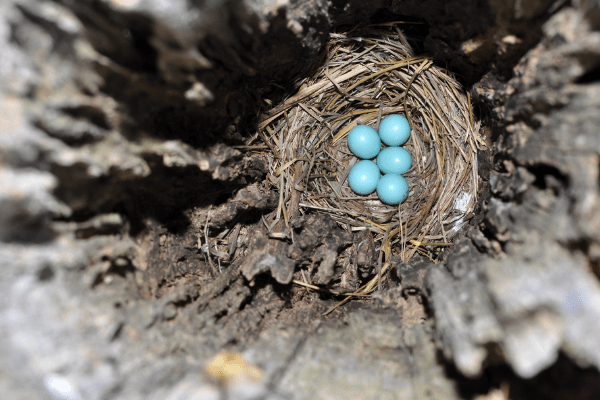
Will A Bluebird Ever Lay Eggs That Aren’t Blue Eggs?
Yes, a bluebird will lay eggs that aren’t blue. It doesn’t happen too often, but on occasion, a bluebird will lay white eggs. And on even rarer occasions, a female bluebird will lay pink eggs.
Here’s an interesting fact:
The differing colors will not alternate in a clutch. For example, if a female lays powder-blue eggs, the entire clutch will consist of powder-blue eggs. The same holds true for white eggs. If one egg is white, the entire clutch will be white. And if one egg is pink, the entire clutch will all consist of pink eggs.
Bluebird Nesting Facts
| Eastern Bluebird | Western Bluebird | Mountain Bluebird | |
| Brood | 1-3 | 1-3 | 1-2 |
| Clutch Size | 2-7 eggs | 2-8 eggs | 4-8 eggs |
| Incubation Period | 11-19 days | 12-17 days | 18-21 days |
Conclusion
At the end of the day, it’s important to keep the following in mind about the color of bluebird eggs:
- For the most part, bluebird eggs are a powdery blue color
- Occasionally bluebird eggs will come out white or pink
- The entire clutch of eggs will be either blue, pink, or white
- Female bluebirds build the nest
- Male bluebirds gather the material for the nest in an effort to attract a mate
- A typical bluebird clutch size is anywhere from 2-8 eggs
I hope you found this information useful and informative Thanks for stopping by!

